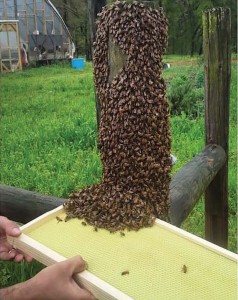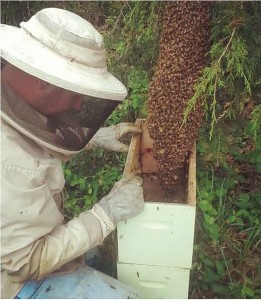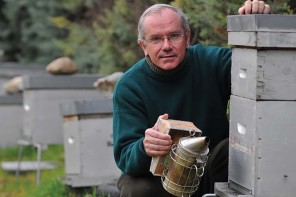What are they and what can beekeepers do about them?
by Jennifer Berry
Ahhh. Spring is finally here. No longer are we dealing with grey, dreary days, cold freezing rain, drying wind chills, ice coated windshields, scratchy wool clothing, high electric bills, shattering teeth and low esteem. No more and what a welcome change.
Spring – the season between Winter and Summer. The season of rebirth, birds chirping, warm days and cool nights. The season in which dormant seeds, bulbs, and buds respond to the surrounding sun-soaked soils and burst forth, exposing daffodils and tulips, red buds and azaleas, violas and more. The season in which frogs and toads, crickets and katydids awaken and fill the air with an orchestra of mating calls. The season the bees are finally able to fly, forage and find food! The season that beekeepers, gardeners, hikers, bikers, runners, writers, painters, and lovers love! The season that . . . bees SWARM! Tulips and Pansies and Swarms. Oh My!
To some, (the bees) swarms are not so bad, but to others (the beekeeper) it sucks. To bees, swarms are a way of life – actually a way to continue the life of the species. In a nutshell, a honey bee swarm is the process where around half of the bees (on average), along with the old queen, split from an existing colony to form a new one. Once the bees leave the original colony, numerous things can occur. The queen – with all the bees in tow – will fly a certain distance from the hive and land on a branch, wall, post, leaf, car, stick, bush, another hive, rock, or boat. Once she has landed, the swarm of bees will surround her, forming a moving mass of bees. They will remain at this location until a) a new home is located or b) a better branch, wall, post, leaf, car, stick, bush, another hive, rock, or boat is found. While in limbo between homes, scout bees will be combing the landscape for another suitable dwelling. Once this is accomplished, the scout bees will fly back to the swarm and through the dance language, explain to the rest of the bees and queen where their new home is located. And then, off they will fly to begin again.
Hopefully, their new residence will have available space for expansion, along with providing insulation and protection from the environment. Plus – hopefully – there will be an adequate nectar flow so they will be able to store enough food to survive the upcoming winter dearth. Unfortunately, less than 25% of swarms survive their first year. It’s sad to think that so many bees die each year, not only from mites and starvation, insecticides and environmental toxins, but also due to swarming.
It is important to recall, though, that swarms are necessary for the survival of the species. If swarming didn’t occur, then the first-ever colony of bees, once it died off, would have also been the last colony of bees. But, because there is not only internal reproduction (the queen laying eggs) but also external reproduction (swarming), the species survives.
So, how does swarming figure into the equation for the beekeeper? Swarms are usually something we don’t want since more than half of the bees and the queen leave the hive. And beekeepers especially don’t like swarms if they are planning on harvesting honey that season. In the perfect world – and what’s best for the bees – the honey crop should be large enough as to not only sustain the bees through months of minimal forage and frigid winter days, but also there should be enough so that the beekeeper can harvest and extract some for friends, family, customers and/or themselves.

Now, sometimes we are lucky and can “hive the swarm” if the queen lands in a convenient and easy to reach location (not on a branch 200 feet in the air).
But what really sucks about swarms, especially for queen breeders, is when their prized queen, (the one they’ve been collecting data on for the past few years; the one they are about to graft from to produce more queens), flies away – or as we seasoned beekeepers like to say, she “hits the trees.”
One of the largest swarms I ever saw was in the top of an old pine tree. It broke my heart because in the middle of that massive, unreachable swarm was one of my favorite queens that I was only days away from grafting from. If only I had a bucket truck, she would have been back inside a comfy hive. Instead, she flew away several days later – never to be seen again.
Over the years, our bee lab receives numerous calls during the Spring months about swarms – from frustrated beekeepers to nervous public folk who are afraid to go outside due to the massive ball of bees that has just formed on the post of their front porch. If we have time, which we rarely do during Spring, we will make an effort to go and collect the swarm (if it’s close and attainable). If not, we get them in contact with a beekeeper that has the time and energy. Some of the more memorable swarm calls have been the ones in cars – especially the brand new convertible Mercedes at a dealership, the ones near a school or playground that were going to “kill the children,” the one at the post office which delayed the mail from being delivered, and – my personal favorite – the one at the Harley Davidson dealership.
I have to tell you about the swarm at the Harley dealership. I got a call – I was told there’s a swarm in a small tree about six feet from the ground, just outside the door of the dealership. The gentleman on the phone seemed calm, but did ask if someone could come immediately because the bees were scaring away customers. Quickly, I grabbed my veil, smoker, brush, bucket, lid, step ladder, complete hive and a spray bottle full of sugar water and headed out. When I arrived, I immediately noticed the swarm. It was in the perfect location: hanging off of a thin branch. I thought to myself, ‘This should be no problem at all.’ As I began to gather my supplies from the truck, a very large – very intimidating – man walks up to me and says, “Excuse me little lady, are you here to deal with those bees?” I responded, “Yes sir, I am.” He looked disappointed, shook his head and then said, “Oh, I see. Why would they send a woman?” Honestly, I didn’t know what to say, so I just laughed and said, “No, they sent a beekeeper – and I’m all you got.”
As I began to head toward the swarm, he followed me. I placed the ladder into position, and stepped up to lightly spritz the bees with sugar water, when I suddenly noticed that there was a crowd of about 20 folks who had gathered outside the dealership. I also noticed the ‘intimidating guy’ was behind me, just feet away, watching my every move. I explained to him that he might want to step back; that swarms are usually very calm but sometimes they can be unpredictable – especially when they get shaken off a branch. They may just fly and sting the first thing they come into contact with, possibly even his face. He said loud enough for the entire crowd to hear, “I ain’t afraid of no bees. Plus, they sent a woman to do a man’s job.” With a wave of his hand and an exasperated puff of air expelled from his lips (as if to imply that I was annoying him), it was obvious he wasn’t concerned about the bees and wanted me to continue; so I did just that.
I know I shouldn’t have, but something deep down from my inner core made me.
As I continued to position myself and the bucket I said “There is one more thing you should know: these bees could be ‘Killer Bees,’ which means this entire cluster, all of these thousands of bees, could take off and sting you and me, and those people by the door. Maybe you should join them, just in case the bees get too aggressive, and head inside if I give the word.” Meanwhile, a few foragers had returned and were starting to fly around his uncapped head. He nervously responded, “How can you tell if they are… ‘Killer Bees’?” I replied, “I won’t know for sure until I shake them into this bucket.” Just then, that’s what I did. I shook the branch and all the bees fell into the bucket, and I yelled, “KILLER BEES!”
I’ve never seen someone take off so quickly. I even heard a high shrill come from him as he ran into the door while trying to open it. Once he was inside, the crowd that had gathered burst into laughter. I quickly put a lid on the bucket and headed back towards the truck. Meanwhile, the manager of the store approached me. He shook my hand and thanked me for retrieving the bees, and also for helping to teach his employee to be more of a gentleman. We laughed and I informed him that I was going to leave a small hive (with a frame of old comb and a queen lure) in the tree where the swarm had been. This will hopefully attract any stragglers or foragers that I was unable to collect in the bucket. Then, I would be back at sunset to collect the hive and – hopefully – the remainder of the bees. Leaving bees behind sometimes can cause an issue; I wanted to make sure there wasn’t going to be, since this was ‘a man’s job.’
So, how can we prevent swarms? Well, that’s the million dollar question with a two dollar answer: we can’t really.

Bees are going to swarm. It’s in their nature as much as it’s in our nature to eat, drink, and breathe. So, preventing swarms really isn’t what we want to attempt; instead, how about we try to reduce swarming? Below are some methods that we have used at the UGA Bee Lab, and in my own personal bee operation, over the years.
Here in the southeast, we begin preparing for swarms as early as December or January, even though, on average, we usually don’t witness the first swarms until March. However, depending on whether the winter weather is above or below average, this may shift that date to February or April. Being prepared is the key to being a good beekeeper.
Several things can occur which trigger bees to swarm. One is the increasing day length. Once the days start getting longer, the queen usually begins to lay eggs, and since she is laying eggs, populations begin to rise, thereby crowding the bees. Also, as the queen continues to lay more eggs, eventually there is a lack of available laying space. Plus, as the bees become more and more crowded the queen pheromone is inadvertently diluted. Next, add a nectar flow and BAM! You have the perfect storm for a swarm. All of these things, whether occurring individually or collectively, can trigger the mass exodus of bees from the parental colony, so, again, we need to be prepared.
As I mentioned, we actually begin our first swarm preparations in December or January. It’s called hive reversals. As the bees are going through winter, they are slowly moving up through the honey stores (which is why it is imperative to put honey stores above the cluster of bees and not below). As they move into the honey supers, they may vacate the boxes below. And, as the population of the colony continues to grow, they begin to bump their heads on the underside of the inner cover or lid, feeling even more cramped. Reversing hive bodies is a simple – yet very effective – method of taking empty boxes from the bottom and reversing them to the top just above where the bees are clustered. But, only do this if there is NO BROOD in the lower box. Otherwise, you will separate (split) the brood into two different locations, and the bee population may not be strong enough to cluster over both areas. Hence, unprotected brood will die (see Figure 1).

After hive reversals, winter progresses into spring and bee populations are reaching a maximum, so all of the hive boxes may be full. Another way to reduce or postpone swarming is by adding more boxes, or supers (supering). This is especially important to do once the nectar flow begins. Another common practice, especially with commercial operations, is to re-queen. As the queen ages her QMP (Queen Mandibular Pheromone) production slows down or is limited. The reduction of QMP in the colony can cause workers to begin to raise queen cells either for supercedure or swarming. By replacing the old queen with a newer one, it may help to reduce or prevent swarming.
Another method, one we do with our research colonies which can’t be allowed to swarm (otherwise we lose data), is to cut queen cells. This method is extremely time consuming when you have more than a few colonies, and it may not always work. The idea here is to cut cells every seven days, since the bees are rearing new queens in preparation for swarming. Remember, the old queen leaves with the swarm usually just prior to the queen cells being capped. Usually – but not always (there are very little absolutes when it comes to bees and beekeeping). If you decide to cut queen cells, you must be on time (every seven days) and inspect every frame, along with every nook and cranny, because if you leave just one cell, they will swarm. Over the years, we have cut thousands of cells, keeping hundreds of swarms from happening. It’s important to remember, though, that if the colony is already in swarm mode, it is going to swarm no matter what you do.
The last method – my favorite, and, in my opinion, the most effective swarm reducing method – is creating an artificial swarm by splitting the colony yourself. This method needs to take place in the early spring months, just prior to swarming (construction of queen cups). To do this, the old queen and several frames of bees, brood, honey and pollen are removed and placed into a separate nuc box and then transported to a different apiary. The remaining parent colony is given empty drawn or undrawn frames to fill the space, a queen cell, a new queen, or is allowed to rear its own. The new colony is still susceptible to swarming, so give them plenty of space by placing them into a 10-frame box and adding a super. Depending on the quality of the old queen, she may be replaced as well.
I hope one of these methods works for you. I’ve tried so many, and have yet to find one that is foolproof.
Spring is an exciting time of year – not only for the beekeeper, but also for the bees. Even though I am losing bees and queens, I love to watch swarms. There’s something magical about the energy of so many bees hitting the air at once; it’s hard to describe. Imagine what it must be like for the bees. What do they feel, leaving the comforts of their home? Launching off and branching out without any security or guarantee that they will find a new home, or a solid patch of flowers, or enough nectar to supply the energy to build comb, raise brood, produce honey, and survive until the next spring. Maybe the comfort of having all their sisters and mom swirling around them, knowing they are helping the species to survive and the excitement of the unknown is enough to keep them going. But, who knows. I guess only the bees do!
Be good to you and your bees!
Jennifer Berry is the Research Director and Chief Beekeeper at the UGA Honey Bee Lab.
Photos by Ben Rouse.








